Related Research Articles

The English longbow was a powerful medieval type of bow, about 6 ft (1.8 m) long. While it is debated whether it originated in England or in Wales from the Welsh bow, by the 14th century the longbow was being used by both the English and the Welsh as a weapon of war and for hunting. English longbows were effective against the French during the Hundred Years' War, particularly in the battles of Sluys (1340), Crécy (1346), Poitiers (1356), and Agincourt (1415). They were less successful later on, as longbowmen had their lines broken at the Battle of Verneuil (1424), although the English won a decisive victory there; they were completely routed at the Battle of Patay (1429) when they were charged by the French mounted men-at-arms before they had prepared the terrain and finished defensive arrangements. The Battle of Pontvallain (1370) had also previously shown longbowmen were not particularly effective when not given the time to set up defensive positions.
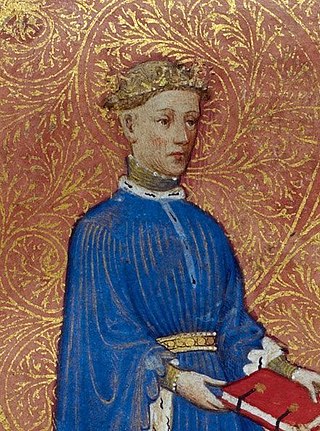
Henry V, also called Henry of Monmouth, was King of England from 1413 until his death in 1422. Despite his relatively short reign, Henry's outstanding military successes in the Hundred Years' War against France made England one of the strongest military powers in Europe. Immortalised in Shakespeare's "Henriad" plays, Henry is known and celebrated as one of the greatest warrior-kings of medieval England.

Henry IV, also known as Henry Bolingbroke, was King of England from 1399 to 1413. Henry’s grandfather Edward III had begun the Hundred Years War by claiming the French throne in opposition to the House of Valois, a claim that Henry would continue during his reign. However, unlike his forebears, Henry was the first English ruler whose mother tongue was English rather than French, since the Norman Conquest, over three hundred years before.
This is a timeline of the history of medicine and medical technology.

Sir Henry Percy, nicknamed Hotspur or Harry Hotspur, was an English knight who fought in several campaigns against the Scots in the northern border and against the French during the Hundred Years' War. The nickname "Hotspur" was given to him by the Scots as a tribute to his speed in advance and readiness to attack. The heir to a leading noble family in northern England, Hotspur was one of the earliest and prime movers behind the deposition of King Richard II in favour of Henry Bolingbroke in 1399. He later fell out with the new regime and rebelled, and was slain at the Battle of Shrewsbury in 1403 at the height of his fame.
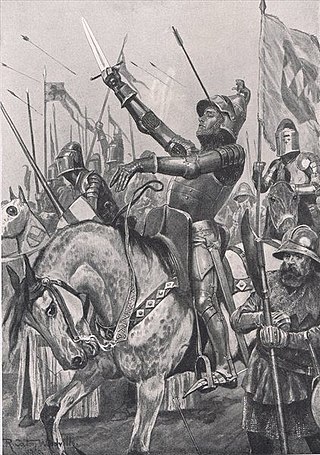
The Battle of Shrewsbury was a battle fought on 21 July 1403, waged between an army led by the Lancastrian King Henry IV and a rebel army led by Henry "Harry Hotspur" Percy from Northumberland. The battle, the first in which English archers fought each other on English soil, reaffirmed the effectiveness of the longbow and ended the Percy challenge to King Henry IV of England.

Ralph Neville, 1st Earl of WestmorlandEarl Marshal, was an English nobleman of the House of Neville.

Abū al-Qāsim Khalaf ibn al-'Abbās al-Zahrāwī al-Ansari, popularly known as al-Zahrawi (الزهراوي), Latinised as Albucasis or Abulcasis, was a physician, surgeon and chemist from al-Andalus. He is considered one of the greatest surgeons of the Middle Ages.

In the Middle Ages, the medicine of Western Europe was composed of a mixture of existing ideas from antiquity. In the Early Middle Ages, following the fall of the Western Roman Empire, standard medical knowledge was based chiefly upon surviving Greek and Roman texts, preserved in monasteries and elsewhere. Medieval medicine is widely misunderstood, thought of as a uniform attitude composed of placing hopes in the church and God to heal all sicknesses, while sickness itself exists as a product of destiny, sin, and astral influences as physical causes. On the other hand, medieval medicine, especially in the second half of the medieval period, became a formal body of theoretical knowledge and was institutionalized in the universities. Medieval medicine attributed illnesses, and disease, not to sinful behaviour, but to natural causes, and sin was connected to illness only in a more general sense of the view that disease manifested in humanity as a result of its fallen state from God. Medieval medicine also recognized that illnesses spread from person to person, that certain lifestyles may cause ill health, and some people have a greater predisposition towards bad health than others.

Ambroise Paré was a French barber surgeon who served in that role for kings Henry II, Francis II, Charles IX and Henry III. He is considered one of the fathers of surgery and modern forensic pathology and a pioneer in surgical techniques and battlefield medicine, especially in the treatment of wounds. He was also an anatomist, invented several surgical instruments, and was a member of the Parisian barber surgeon guild.
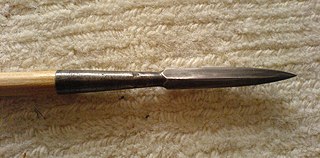
A bodkin point is a type of arrowhead. In its simplest form it is an uncomplicated squared metal spike, and was used extensively during the Middle Ages. The typical bodkin was a square-section arrowhead, generally up to 11.5 cm (4.5 in) long and 1 cm (0.39 in) thick at its widest point, tapered down behind this initial "punch" shape. Bodkin arrows complemented traditional broadhead arrows, as bodkin point arrows were designed to defeat mail armor while broadhead point arrows caused more serious wounds and tissue damage.
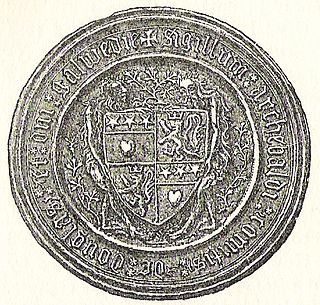
Archibald Douglas, 4th Earl of Douglas, Duke of Touraine, was a Scottish nobleman and warlord. He is sometimes given the epithet "Tyneman", but this may be a reference to his great-uncle Sir Archibald Douglas.
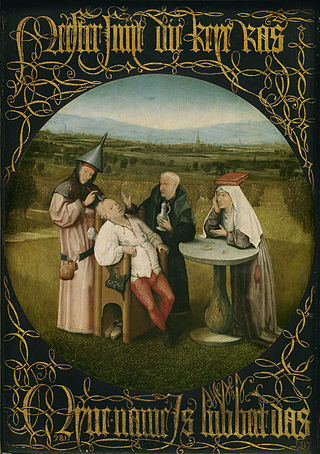
Surgery is the branch of medicine that deals with the physical manipulation of a bodily structure to diagnose, prevent, or cure an ailment. Ambroise Paré, a 16th-century French surgeon, stated that to perform surgery is, "To eliminate that which is superfluous, restore that which has been dislocated, separate that which has been united, join that which has been divided and repair the defects of nature."

A surgical suture, also known as a stitch or stitches, is a medical device used to hold body tissues together and approximate wound edges after an injury or surgery. Application generally involves using a needle with an attached length of thread. There are numerous types of suture which differ by needle shape and size as well as thread material and characteristics. Selection of surgical suture should be determined by the characteristics and location of the wound or the specific body tissues being approximated.
Gilbertus Anglicus was a medieval English physician. He is known chiefly for his encyclopedic work, the Compendium of Medicine, most probably written between 1230 and 1250. This medical treatise was an attempt at a comprehensive overview of the best practice in pharmacology, medicine, and surgery at the time. His medical works, alongside those of John of Gaddesden, "formed part of the core curriculum that underpinned the practice of medicine for the next 400 years".
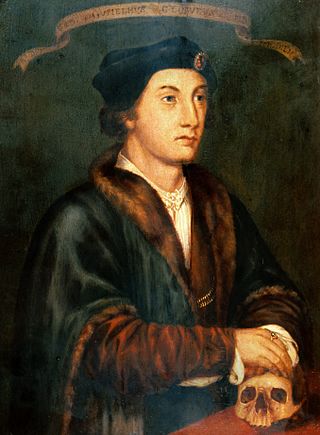
William Clowes the Elder was an early English surgeon. He published case reports in which he advocated the application of powders and ointments. He also published one of the first reports in English on how to reduce a femur.
Gilbert Kymer was Dean of Salisbury Cathedral, Chancellor of Oxford University, and a physician.
Sir Laurence Merbury was an English-born statesman in Ireland who held the office of Treasurer of Ireland and was also Deputy to the Lord Chancellor of Ireland.

Thomas Morstede was an esquire and English surgeon who served the three successive kings, Henry IV, Henry V and Henry VI of England. He was described by Theodore Beck as the "most eminent English surgeon of the fifteenth century".

Ancient Roman surgical practices developed from Greek techniques. Roman surgeons and doctors usually learned through apprenticeships or studying. Ancient Roman doctors such as Galen and Celsus described Roman surgical techniques in their medical literature, such as De Medicina. These methods encompassed modern oral surgery, cosmetic surgery, sutures, ligatures, amputations, tonsillectomies, mastectomies, cataract surgeries, lithotomies, hernia repair, gynecology, neurosurgery, and others. Surgery was a rare practice, as it was dangerous and often had fatal results. To perform these procedures, they used tools such as specula, catheters, enemas, bone levers, osteotomes, phlebotomes, probes, curettes, bone drills, bone forceps, cupping vessels, knives, scalpels, scissors, and spathas.
References
- 1 2 Green, Monica H. (20 March 2008). Making Women's Medicine Masculine: The Rise of Male Authority in Pre-Modern Gynaecology. OUP Oxford. p. 56. ISBN 978-0-19-160735-6.
- ↑ Getz, Faye (2 November 1998). Medicine in the English Middle Ages. Princeton University Press. p. 8. ISBN 978-1-4008-2267-6.
- 1 2 Lang, S. J. (2004). "Bradmore, John (d. 1412), surgeon" . Oxford Dictionary of National Biography (online ed.). Oxford University Press. doi:10.1093/ref:odnb/45759 . Retrieved 2 September 2023.(Subscription or UK public library membership required.)
- ↑ Cooper, Stephen; Curry, Anne (2014). Agincourt: Myth and Reality, 1415–2015. Pen and Sword. ISBN 978-1-4738-3518-4.
- 1 2 3 Given-Wilson, Chris (1996). An Illustrated History of Late Medieval England. Manchester University Press. p. 96. ISBN 978-0-7190-4152-5.